
Jane “Janie” Carriere

My name is Jane Carriere, although I often go by Janie. I am 28 years old and was born with a disability, spina bifida. I have been making art ever since I was old enough to pick up a pencil. As I got older, I found myself instinctively using artmaking and other creative pursuits to facilitate personal growth and healing (examples of this work from high school and undergraduate are included below). However, I did not find out that art therapy was its own field until I was a junior in high school. From that moment on, I knew who I was and what I was being called to do. I became laser-focused on answering the call to my vocation as an art therapist. After years of hard work in college, setbacks related to my health and personal life, and a challenging discernment process to find the right program for me, I discovered the art therapy program here at Saint Mary-of-the-Woods. This program allowed me to grow as a student, artist, future art therapist, and as a person. The artwork I created over the last 2+ years demonstrates my growth and lessons I have learned along the way. I chose several pieces and grouped them into categories that reflect 5 of the most important lessons I learned.

“Art Therapist Self-Box” – Jane Carriere, 2018 | mixed media, including a wood box, acrylic paint, marker, and collage 
“Art Therapist Self-Box,” front cover – Jane Carriere, 2018 | mixed media, including a wood box, acrylic paint, marker, and collage 
“Art Therapist Self-Box,” back cover – Jane Carriere, 2018 | mixed media, including a wood box, acrylic paint, marker, and collage 
“Art Therapist Self-Box,” interior – Jane Carriere, 2018 | mixed media, including a wood box, acrylic paint, marker, and collage 
“Art Therapist Self-Box,” spine – Jane Carriere, 2018 | mixed media, including a wood box, acrylic paint, marker, and collage
Lesson 1 – Cultivation of my Art Therapist Identity: Inner/Outer Box
Every art therapy student enters the program with a different set of life experiences, different goals, different interests, and a different path ahead of them. A common thread in many of my classes has been the cultivation of our art therapist identities. The piece that represents my identity the most is an inner/outer box that I created early in the program (2018, mixed media, including a wood box, acrylic paint, marker, and collage). This piece allowed me to simultaneously express my love for art therapy, excitement getting to serve others while doing something that I love, while still acknowledging my insecurities and fears about pursuing a career in this field, including impostor syndrome, financial concerns, and concerns about my health and stamina as a woman with a disability. The tension between my inner world and outer persona became another important theme in my work during my time at SMWC. We all have tensions between our inner and outer worlds, which I believe is useful for us to explore through art.
Lesson 2 – The Importance of Exploring Persona and Shadow: Mask-making
As I continued in the program, I learned more about the tension between our outer personas, inner world, and the things we keep in the shadows of our inner world. Mask-making (2019-2020, mixed media) allowed me to delve deeper into the shadows of my subconscious and conscious beliefs, understand what I am hiding from others (and even myself), and begin letting these shadows come into the light. The masks in my exhibit deal my identity as a person with a disability and my struggles with impostor syndrome. The persona side of the disability mask relates to feeling pressured to be “the gold standard” of an inspirational person with a disability, while the shadow side acknowledges feelings of frustration, tiredness, occasional jealousy of able-bodied people, etc. The next mask was created between the end of my practicum and beginning of my internship. It acknowledges how excited I am to be working in the field as an intern and the growth and hard work it took to get to that point. The inner mask tells the other side of the story: my fears of being in over my head and drowning in work, feeling frozen when I tried to make the right choices, and feeling too inexperienced to be effective. Bringing the shadows to light takes away some of their power over us.
“My soul will rest in your embrace…Take me deeper than my feet could ever wander, that my faith would be made stronger.”
Oceans (Where Feet May Fail), (Hillsong United, 2013)
Lesson 3 – Creating Personally Meaningful Symbols: Hands Holding Flowers
Early in the program, I created an image of my classmates and I collaborating to plant a bud. This image of hands holding a flower would reappear in my artwork throughout the years. These images reflected uprooting, taking root in new places, upheaval, and growth. The image I included in my art show (2019, marker on paper) depicts a flower being gently held and protected from lightning and turbulent seas. It is paired with lyrics from a song called “Oceans (Where Feet May Fail).” In this image, the sunflower is me, as I ventured into new challenges. The hands and the lyrics are an acknowledgment that I am safe from harm as I make my way through this journey. I anticipate continuing to see this symbol pop up in my future work, particularly when I experience life changes and challenges.
Lesson 4 – Increasing Spiritual Awareness: Depicting Dreams & Daydreams
Getting in touch with my dreams and my spirituality became a vitally important aspect of my journey and my artwork midway through the program. I have always had vivid dreams and an interest in understanding my dream-world. In 2019, I took a class on symbolism, metaphor, and spirituality, in which I became increasingly aware of what my subconscious was telling me in dreams and what God was telling my heart through prayer and meditation. “Woman with Rainbow Hair” (mixed media, 2019) was a powerful dream image that helped me realize I was healing from trauma and returning to my authentic self. “God Winks” (marker, 2019) was inspired by a prayer answered in an unexpected way. I felt connected to my spiritual practices in a deeper way than I had in a long time after musing on this experience and this image. I was reminded of the importance of my personal spirituality and the importance of honoring each client’s unique spirituality.

“Adulting Stickers For Mediocre Days” – Jane Carriere, 2019 | sketch created in 2019, digital stickers created in 2020, digital image created on Canva.com 
“Imposter Syndrome vs. The Intern” – Jane Carriere, 2020 | digital image created on Canva.com 
“Quiet Little Mouse” – Jane Carriere, 2019 | colored pencil and pen on paper
Lesson 5 – Learning through Laughter: Utilizing Humor in Response Art
The final lesson I wanted to share was the importance of using humor in my artwork. I am a perfectionist, and I used to take myself and my smallest mistakes far too seriously. It became important for me to learn to laugh at myself instead of berating myself for every mistake. That lesson inspired a recurring character in my response art, “The Quiet Little Mouse.” She was the result of a day where I felt I was getting in the way of clients’ progress and my own progress. She looked to me like a character straight out of a Beatrix Potter book, and that realization made me smile. She has recurred in response art when I was processing feelings of inadequacy. My peers and professors have pointed out that she is an endearing and positive little character, encouraging me to note the way she tries her best and how open and ready she is to work with her clients. She helps me be kind to myself. I created “Adulting Stickers for Mediocre Days” when I decided to acknowledge things I had done well on an otherwise uneventful day. These included wearing matching socks, drawing pretty flowers in session, and only needing two cups of coffee to get through the day. Reflecting on all these tiny reasons to smile helped me realize that having a mediocre day is fine sometimes. I can appreciate the little things on those days. My final image was one of my last response pieces this semester. “Impostor Syndrome vs. The Intern” is a comic strip-style image that pokes fun at my struggles with impostor syndrome before I took on a new responsibility at my site. As it happened, The Intern won out over the dreaded Impostor Syndrome. Overcoming obstacles has been a theme throughout my life, and my journey to complete this program has been no exception.
Final Thoughts
In closing, thank you to my incredible support system who has accompanied me on this journey: my family, my friends, my wonderful Philip, my cohort, my professors, my advisors, and my supervisors. I could not have done this without you.
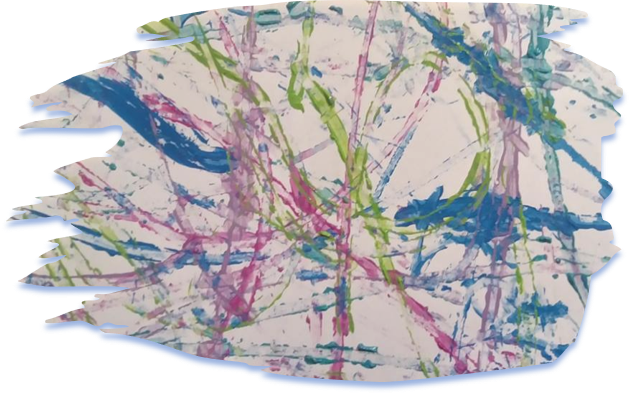

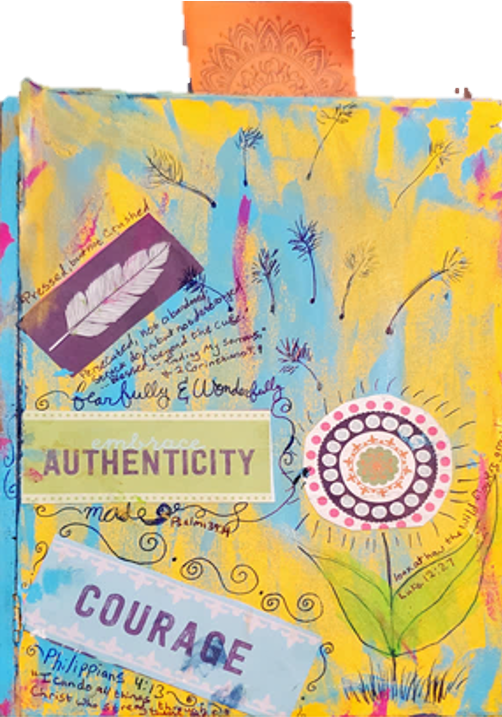






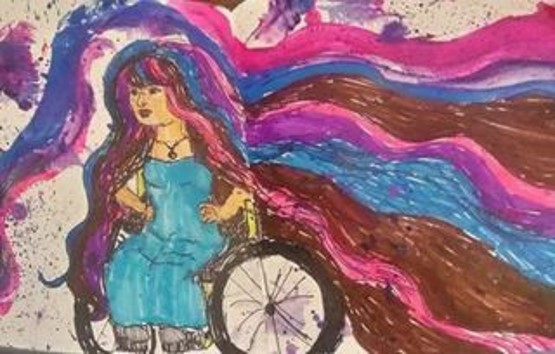
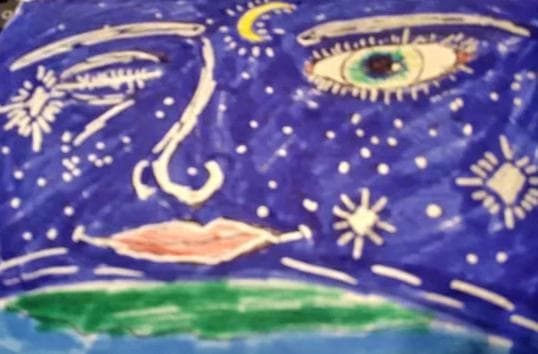

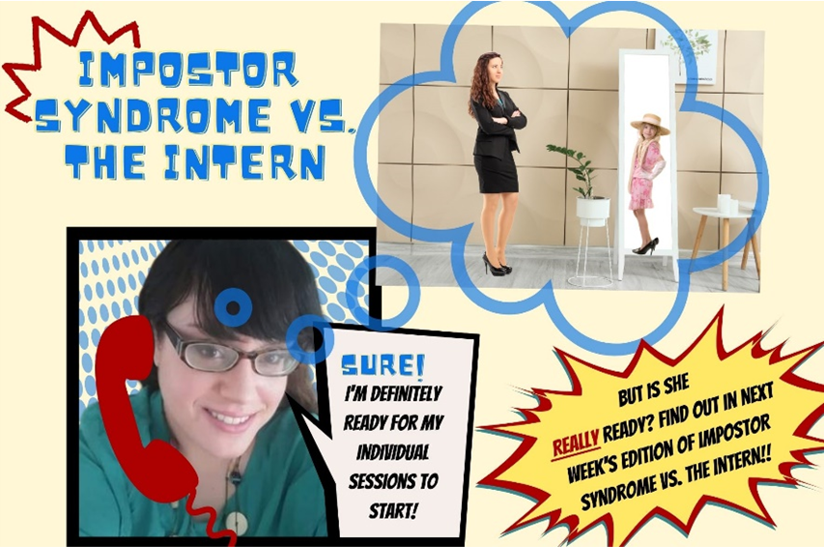

8 Comments